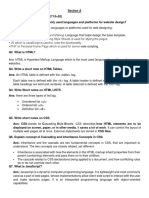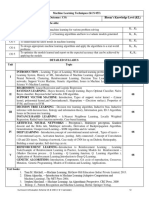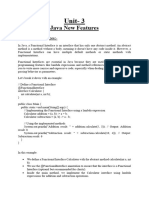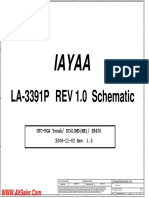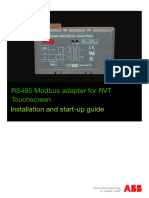Software Engineering Quantum
Uploaded by
pikaachuu.209Software Engineering Quantum
Uploaded by
pikaachuu.209B.TECH.
(CSE & CS)
SIXTH SEMESTER (DETAILED SYLLABUS)
Software Engineering (KCS-601)
Course Outcome ( CO) Bloom’s Knowledge Level (KL)
At the end of course, the student will be able to
Explain various software characteristics and analyze different software Development
CO 1 K1, K2
Models.
Demonstrate the contents of a SRS and apply basic software quality assurance practices to
CO 2 K1, K2
ensure that design, development meet or exceed applicable standards.
CO 3 Compare and contrast various methods for software design K2, K3
Formulate testing strategy for software systems, employ techniques such as unit testing, Test
CO 4 K3
driven development and functional testing.
Manage software development process independently as well as in teams and make use of
CO 5 K5
Various software management tools for development, maintenance and analysis.
DETAILED SYLLABUS 3-1-0
Unit Topic Proposed
Lecture
Introduction: Introduction to Software Engineering, Software Components, Software
Characteristics, Software Crisis, Software Engineering Processes, Similarity and Differences from
I Conventional Engineering Processes, Software Quality Attributes. Software Development Life 08
Cycle (SDLC) Models: Water Fall Model, Prototype Model, Spiral Model, Evolutionary
Development Models, Iterative Enhancement Models.
Software Requirement Specifications (SRS): Requirement Engineering Process: Elicitation,
Analysis, Documentation, Review and Management of User Needs, Feasibility Study, Information
II Modelling, Data Flow Diagrams, Entity Relationship Diagrams, Decision Tables, SRS Document, 08
IEEE Standards for SRS. Software Quality Assurance (SQA): Verification and Validation, SQA
Plans, Software Quality Frameworks, ISO 9000 Models, SEI-CMM Model.
Software Design: Basic Concept of Software Design, Architectural Design, Low Level Design:
Modularization, Design Structure Charts, Pseudo Codes, Flow Charts, Coupling and Cohesion
Measures, Design Strategies: Function Oriented Design, Object Oriented Design, Top-Down and
III Bottom-Up Design. Software Measurement and Metrics: Various Size Oriented Measures: 08
Halestead’s Software Science, Function Point (FP) Based Measures, Cyclomatic Complexity
Measures: Control Flow Graphs.
Software Testing: Testing Objectives, Unit Testing, Integration Testing, Acceptance Testing,
Regression Testing, Testing for Functionality and Testing for Performance, TopDown and Bottom-
Up Testing Strategies: Test Drivers and Test Stubs, Structural Testing (White Box Testing),
IV Functional Testing (Black Box Testing), Test Data Suit Preparation, Alpha and Beta Testing of 08
Products. Static Testing Strategies: Formal Technical Reviews (Peer Reviews), Walk Through,
Code Inspection, Compliance with Design and Coding Standards.
Software Maintenance and Software Project Management: Software as an Evolutionary Entity,
Need for Maintenance, Categories of Maintenance: Preventive, Corrective and Perfective
V Maintenance, Cost of Maintenance, Software Re- Engineering, Reverse Engineering. Software 08
Configuration Management Activities, Change Control Process, Software Version Control, An
Overview of CASE Tools. Estimation of Various Parameters such as Cost, Efforts,
Curriculum & Evaluation Scheme CS & CSE (V & VI semester) 21
ST U D YZONE A D I T YA .COM
www.studyzoneaditya.com
ENGINEERING ALL CONTENTS
Books, Quantum, Typing Notes, Handwritten Notes,
Practical File's And All Engineering Study Materials
Available Here.
For more details visit and follow touch to icons below
studyzoneaditya.com B.TECH STUDY ZONE
STUDY ZONE B.TECH STUDY ZONE
ST U D YZONE A D I T YA .COM
www.studyzoneaditya.com
ENGINEERING ALL CONTENTS
Books, Quantum, Typing Notes, Handwritten Notes,
Practical File's And All Engineering Study Materials
Available Here.
For more details visit and follow touch to icons below
studyzoneaditya.com B.TECH STUDY ZONE
STUDY ZONE B.TECH STUDY ZONE
You might also like
- Service Manual Acer Aspire 8943 8943g 04212010No ratings yetService Manual Acer Aspire 8943 8943g 04212010328 pages
- Theory Automata and Formal Theory Automata and Formal Language QuantumNo ratings yetTheory Automata and Formal Theory Automata and Formal Language Quantum79 pages
- Operating System Handwritten Notes All UnitNo ratings yetOperating System Handwritten Notes All Unit107 pages
- Network Layer: Delivery, Forwarding, and RoutingNo ratings yetNetwork Layer: Delivery, Forwarding, and Routing62 pages
- Quantum Design and Analysis of Algorithms Full PDFNo ratings yetQuantum Design and Analysis of Algorithms Full PDF196 pages
- SmartHealthPrediction Report Django - Report - Updateed 1 1No ratings yetSmartHealthPrediction Report Django - Report - Updateed 1 183 pages
- Human Posture Recognition System: Kallam Haranadha Reddy Institute of TechnologyNo ratings yetHuman Posture Recognition System: Kallam Haranadha Reddy Institute of Technology17 pages
- BCS452 - Object Oriented Programming With Java Lab0% (1)BCS452 - Object Oriented Programming With Java Lab3 pages
- Ex No: 6 Raw Sockets (Packet Capturing & Filtering)No ratings yetEx No: 6 Raw Sockets (Packet Capturing & Filtering)6 pages
- BCT Techknowledge Want All Subjects Notes PlsNo ratings yetBCT Techknowledge Want All Subjects Notes Pls193 pages
- Natural Language Processing: by Dr. Parminder KaurNo ratings yetNatural Language Processing: by Dr. Parminder Kaur26 pages
- Opening Report - (2023-24) - DSTL - BCS303No ratings yetOpening Report - (2023-24) - DSTL - BCS3032 pages
- Analysis and Verification of Key Performance Parameters of Cellular Network On Cemod PortalNo ratings yetAnalysis and Verification of Key Performance Parameters of Cellular Network On Cemod Portal6 pages
- Silicon Ray Online Electronic Store - Boards - Kits - Components - Modules - ToolsNo ratings yetSilicon Ray Online Electronic Store - Boards - Kits - Components - Modules - Tools2 pages
- Practical-4: Aim: Learn Basics of Cisco Packet Tracer (CPT) and Establish Peer To PeerNo ratings yetPractical-4: Aim: Learn Basics of Cisco Packet Tracer (CPT) and Establish Peer To Peer2 pages
- Verilog: Yogesh Tiwari Assistant Professor Cspit, CharusatNo ratings yetVerilog: Yogesh Tiwari Assistant Professor Cspit, Charusat40 pages
- TestNG - Assignment Problem Scenario & InstructionsNo ratings yetTestNG - Assignment Problem Scenario & Instructions5 pages
- Placa 30 - Toshiba Satellite A135 Compal LA-3391P IAYAA Rev1.0 Schematic PDFNo ratings yetPlaca 30 - Toshiba Satellite A135 Compal LA-3391P IAYAA Rev1.0 Schematic PDF48 pages
- 2GCS212013A0050 - RS485 Adapter-Installation and Start-Up GuideNo ratings yet2GCS212013A0050 - RS485 Adapter-Installation and Start-Up Guide24 pages
- A Guide For Installing Fedora Core 9 On An I386 (x86) PCNo ratings yetA Guide For Installing Fedora Core 9 On An I386 (x86) PC7 pages
- Theory Automata and Formal Theory Automata and Formal Language QuantumTheory Automata and Formal Theory Automata and Formal Language Quantum
- Quantum Design and Analysis of Algorithms Full PDFQuantum Design and Analysis of Algorithms Full PDF
- SmartHealthPrediction Report Django - Report - Updateed 1 1SmartHealthPrediction Report Django - Report - Updateed 1 1
- Human Posture Recognition System: Kallam Haranadha Reddy Institute of TechnologyHuman Posture Recognition System: Kallam Haranadha Reddy Institute of Technology
- BCS452 - Object Oriented Programming With Java LabBCS452 - Object Oriented Programming With Java Lab
- Ex No: 6 Raw Sockets (Packet Capturing & Filtering)Ex No: 6 Raw Sockets (Packet Capturing & Filtering)
- Natural Language Processing: by Dr. Parminder KaurNatural Language Processing: by Dr. Parminder Kaur
- Analysis and Verification of Key Performance Parameters of Cellular Network On Cemod PortalAnalysis and Verification of Key Performance Parameters of Cellular Network On Cemod Portal
- Silicon Ray Online Electronic Store - Boards - Kits - Components - Modules - ToolsSilicon Ray Online Electronic Store - Boards - Kits - Components - Modules - Tools
- Practical-4: Aim: Learn Basics of Cisco Packet Tracer (CPT) and Establish Peer To PeerPractical-4: Aim: Learn Basics of Cisco Packet Tracer (CPT) and Establish Peer To Peer
- Verilog: Yogesh Tiwari Assistant Professor Cspit, CharusatVerilog: Yogesh Tiwari Assistant Professor Cspit, Charusat
- TestNG - Assignment Problem Scenario & InstructionsTestNG - Assignment Problem Scenario & Instructions
- Placa 30 - Toshiba Satellite A135 Compal LA-3391P IAYAA Rev1.0 Schematic PDFPlaca 30 - Toshiba Satellite A135 Compal LA-3391P IAYAA Rev1.0 Schematic PDF
- 2GCS212013A0050 - RS485 Adapter-Installation and Start-Up Guide2GCS212013A0050 - RS485 Adapter-Installation and Start-Up Guide
- A Guide For Installing Fedora Core 9 On An I386 (x86) PCA Guide For Installing Fedora Core 9 On An I386 (x86) PC










